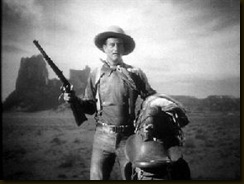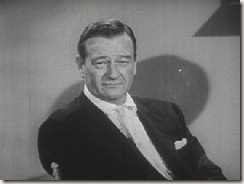
John Wayne worked for Fox Film corporation for $75 a week in small roles. he was given on-screen credit once as 'Duke Morrison' in 'Words and Music'(1929). In 1930, John got his first starring role by director Raoul Walsh in 'The Big Trail'. Walsh suggested the screen name 'Anthony Wayne' after the Revolution War general 'Mad Anthony' Wayne. Fox Studio chief Winfield Sheehan rejected the name. Walsh suggested another name 'John Wayne'. Sheehan liked and agreed the screen name. The name stuck. Wayne himself wasn't there for the discussion. Wayne's pay was raised to $105 a week.
'The big Trail was the first big budget outdoor spectacular of the sound era and cost over $2 million. "The Big Trail' utilized hundreds of extras, wide scenes of the American Southwest. It was filmed in two versions, the standard 35mm and Grandeur. The audience that saw the film in Grandeur stood and cheered. Unfortunately, at the time only a handful of theaters were equipped to show the film in its widescreen process, make the effect a large waste. 'The big Trail' was considered a failure.
After the failure of 'The Big Trail', Wayne was banished back to small roles. He played a corpse in 'The Deceiver' (1931). He appeared in the serial 'The Three Musketeers' (1933), A updated version of Alexander Dumas' navel in which the principal characters were soldiers in the French foreign Legion. He appeared in many low-budget westerns and serials. Eighty westerns Wayne estimated he had appeared in between 1930-1939. Wayne was mentored by stuntmen in riding and other cowboy skills. Wayne and Yakima Canutt (a famed stuntman) developed and perfected stunts used today.
Wayne's breakthrough role came in John Ford's classic 'Stagecoach' (1939). Ford had difficulty in getting financing for 'Stagecoach' because of Wayne's non-star status. After getting rejections from all the top studios, Ford turned to and struck a deal with independent producer, William Wellman. 'Stagecoach' became a huge success and Wayne became a star. Wayne later appeared in over twenty of John Ford's films. Some of those films are 'She Wore A Yellow Ribbon' (1949), 'The Quiet Man' (1952), 'The Searchers' (1956), 'The Wings of Eagles' (1957), and 'The Man Who Shot Liberty Valance' (1962).
The first colored film John Wayne appeared in was 'Shepherd of the Hills' (1941). He co-starred with his longtime friend, Harry Carey.
In 1942, John Wayne appeared in his only film directed by Cecil B. DeMille, 'Reap the Wild Wind'. He co-starred with Ray Milland and Paulette Goddard. It was also one of those rare times Wayne played a character of questionable values.
Wayne was offered the starring role in the film 'All the King's Men' (1949) by director Robert Rossen. Wayne rejected the role because he thought the script was un-American.
Wayne lost the leading role in 'The Gunfighter' (1950) due to his refusal to work for Columbia Pictures chief Henry Cohn (Henry Cohn had mistreated Wayne when he was a young contract.). The lead role in 'The Gunfighter' went to Gregory Peak later.
One of John Wayne's popular roles was his portrayal of a heroic copilot in the film 'The High and the Mighty'. Wayne also played aviators in the films 'Flying Tigers' (1942), 'Flying Leatherneck' (1951), 'Island in the Sky" (1953), 'the Wings of Eagles' (1957), and 'Jet Pilot' (1957).
John Wayne won the Best Actor Oscar for 'True Grit' (1969). He was also nominated as producer of Best Picture for 'The Alamo' and 'The Green Berets' (1968). John Wayne's last film was 'The Shootist' (1976).
*************************
I put this section here for people who came from the tribute page I have up on my main website, "Midnight Angel's Place". Home will take you back to the tribute page of John Wayne on my main website. The other links will take you to the other segments about John Wayne.
Home
John Wayne-Early Life
John Wayne-Personal Life
John Wayne-Politics
John Wayne-Military Conterversy
John Wayne-Death
John Wayne-Congressional Gold Medal and Presidential Medal of Freedom
Winds Of The Wasteland-This is a movie John Wayne starred in.
*************************

